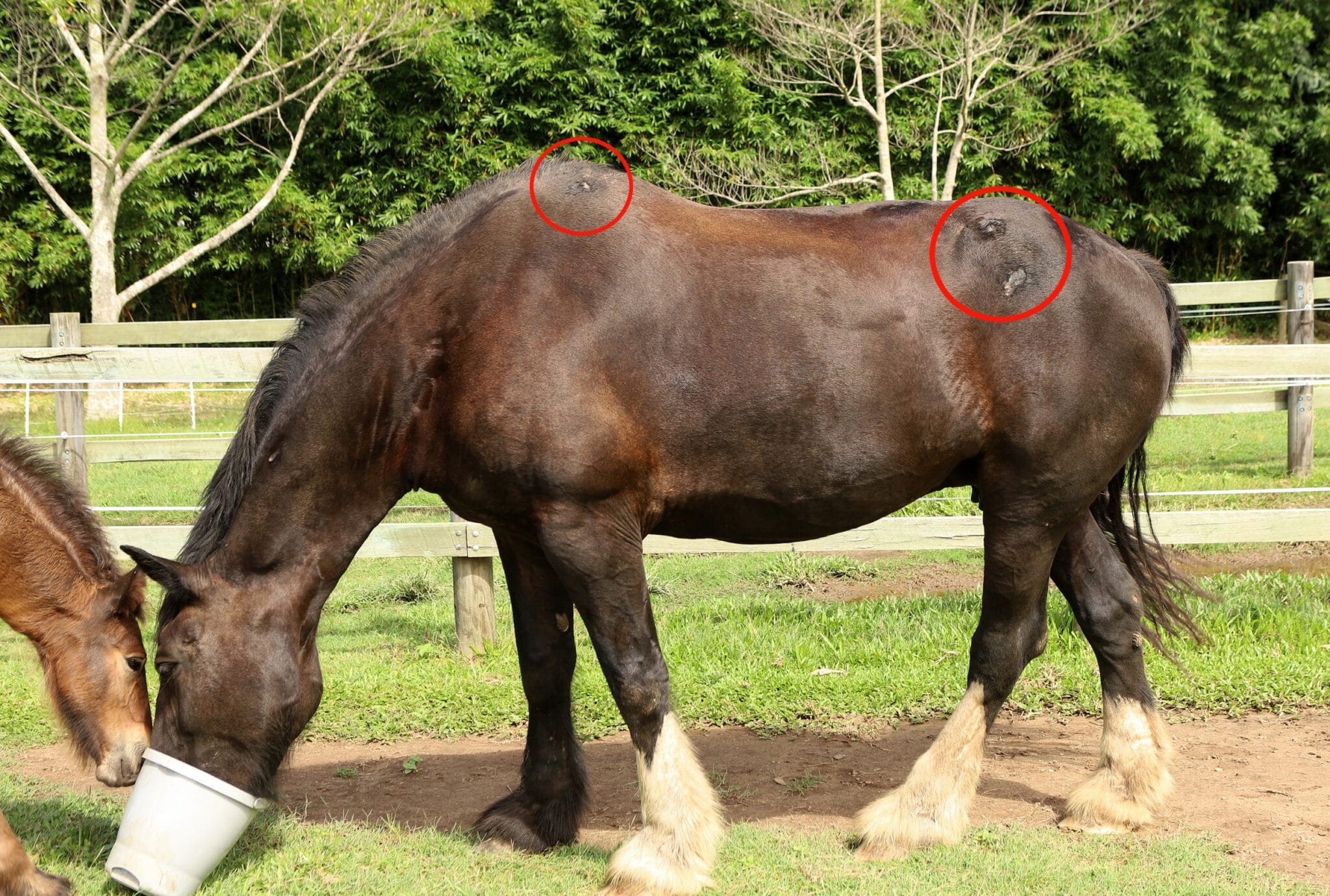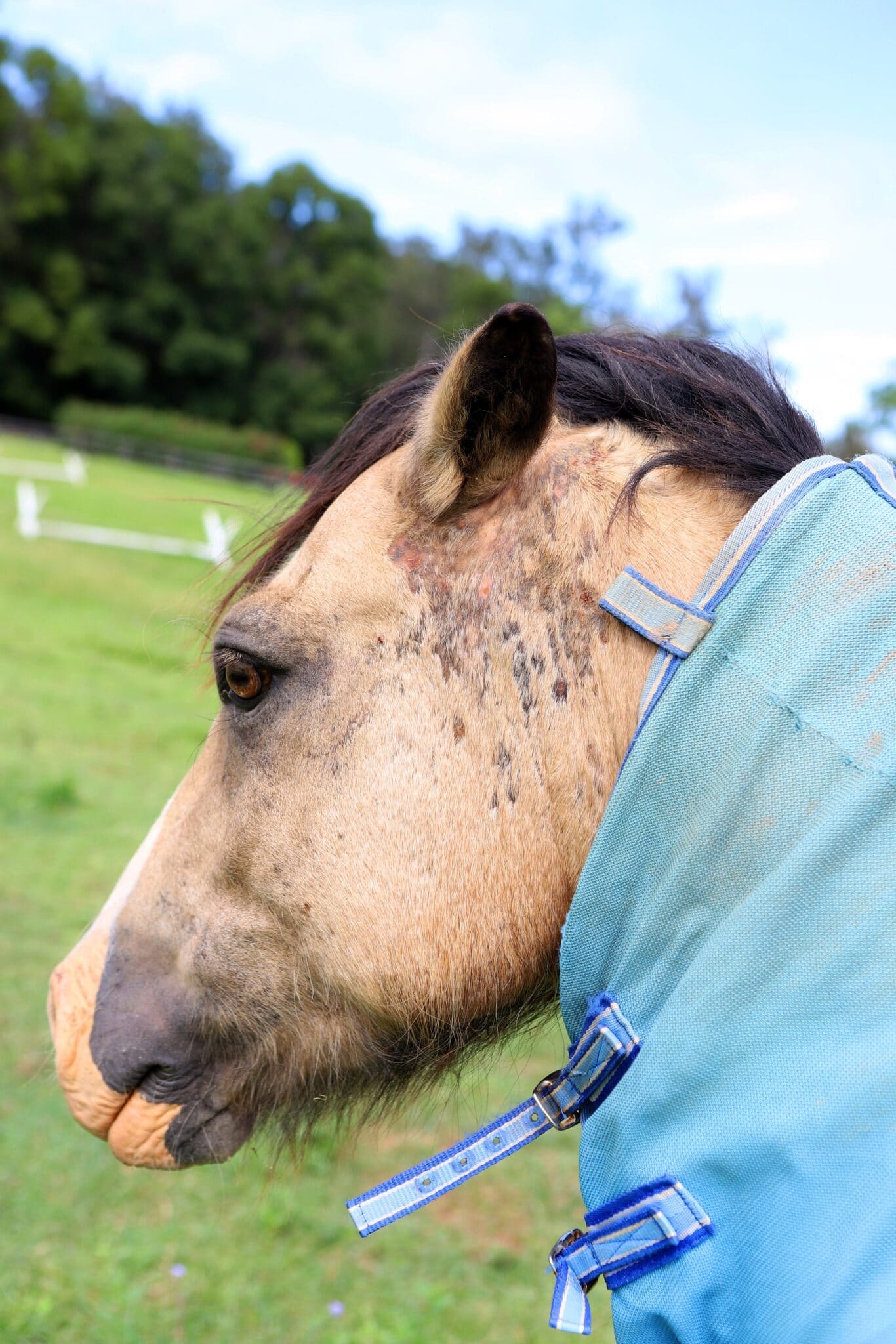Queensland Itch, Sweet Itch, Summer Itch, insect bite sensitivity – no matter what causes the itch, your horse will scratch. Veterinarian DR. DOUG ENGLISH discusses this frustrating problem.

Itch is the most common skin problem in equines, and one of the most frustrating for horse owners. It occurs world-wide wherever there are insects that bite horses. But to complicate diagnosis, it can also be confused with other maladies that can coexist alongside Queensland Itch.
So what’s actually happening to cause an itch? It’s a response to secretions released by the insect when it bites, which causes reactive skin cells called macrophages to produce inflammatory agents such as histamines and cytokines.
Cytokines are molecules that enable cell-to-cell communication in the event an immune response is necessary somewhere in the body. They encourage cells to move towards the site of the inflammation – an insect bite, for example.
The itch causal agent in the majority of dogs has been identified as Interleukin IL31 and an antibody, Cytopoint, has been manufactured to eliminate it. This has proved very effective over a period of a month or two with dogs, and there is work in progress to identify a similar cytokine in horses. An antibody for horses would be very effective with virtually no side effects. And by all means watch this space – but don’t hold your breath!
What’s to blame?
There are many insects that can cause an itch: sandflies, blackflies, midges, mosquitoes, and your ordinary fly, all types that mostly swarm and feed at dusk and dawn.
To confuse the issue, there are certain other maladies which can make an accurate itch diagnosis difficult, including bacterial skin infections such as rain scald, greasy heel and mud fever; cattle ticks, either the larvae or adults; neck threadworm; fungal infections such as various ringworms; pin worms, which can cause tail rubbing; mites including scrub itch; trombiculid or harvest mites in bedding; lice; larvae of the Ixodes tick, more commonly known as the paralysis tick; pemphigus, a skin disorder causing blisters or pus-filled bumps; photosensitisation from particular plants and grasses; and allergies to other antigens. And to top it off, biting stomoxys, or stable flies, will add to the reaction, making matters even worse.
Itch symptoms
There’s some evidence that animals introduced from a different environment are more susceptible to various forms of itch then locally raised animals. But whether local or a newcomer, the symptoms are distressing: intense itching, skin loss, and scabbing and bleeding over the neck, under the belly and the tail caused by rubbing on rails and trees. Unfortunately these symptoms generally become worse as the animal ages and will eventually be evident all year round.
In more advanced cases, hyperkeratosis (thickening of skin) is seen, and in chronic cases fibrosis and hypertrophy (scarring) of epidermal tissue occurs.

Diagnosis
The best initial itch diagnosis, apart from an educated guess, is to submit skin scrapings taken from a few sites – followed by a punch biopsy if necessary – to a good laboratory for microscopic analysis.
However, as I mentioned previously, diagnosis is not a simple matter because of the potential for disorders to coexist with each other. But if the symptoms appear seasonally at times of maximum insect activity, usually during summer, and the paddock is swampy or near water with scrubby sheltered terrain and plenty of insect activity, then itch is the likely culprit. Unfortunately, in some warmer areas insects occur all year round and once highly sensitised, the affected animal can itch all year.
Intradermal skin tests can be used to accurately identify the allergen causing the problem, but they’re expensive, need a lot of interpretation, and can become confusing when multiple reactions are discovered.

Prevention
If your horse is stabled, one of the better ways to prevent itch-causing bugs from biting is to install a fan in either the side of the stable or the roof. Insects can’t fly into even a light wind, and a fan moving air as slowly as five kilometres an hour will blow them away.
Similarly, open, windy paddocks (think brush-free hills) will have little insect activity as opposed to scrub areas that are protected from the wind. And whatever you do, keep well away from wet swampy areas.

A light rug will also help to reduce or prevent insect contact. There are many rugs specifically made for this purpose and these often cover the head and ears. You might also consider screening stables with gauze that has a gauge small enough to keep insects out. And even if your horse is a lover of the great outdoors, keep them in a stable with insect protection during dawn and dusk when insect activity is at its greatest.
Treatments
Cortisone: Cortisones can be used both topically as a cream, or injected. But a word of caution: cortisone injections can thin the skin, predispose to laminitis, and reduce the action of the immune system. However, they are effective, work fast, and provide relief while you wait for other methods to take effect. Daily dosing is necessary and I prefer oral prednisolone. I am not a big fan of depo injections (those that are effective over a longer period of time) because they are expensive and the dose cannot be adjusted.
Topical applications work locally on the outer skin in that specific area and don’t affect other parts of the body. Neocort ointment, Neotopic, and Cortavance spray from your vet, which I prefer, are all good options. However, the bottom line with cortisones is that they do not cure, but they do reduce the symptoms.
Antihistamines: Many types of antihistamines are available, but they’re not very reliable, not effective for severe itching, and have to be given every eight hours. Cetirizine, hydroxyzine, diphenhydramine are all antihistamines, are given orally and reduce milder symptoms.
Insect repellent sprays: These sprays are especially useful, and many are on the market, but they do need to be applied regularly.
Emollient and essential oils: Citronella, camphor, tea tree, lemon myrtle, eucalyptus, bergamot, geranium, eucalyptus, and lemon grass all have insect repellent, surface calming, and healing actions. They should be applied in a carrier oil such as castor, coconut, almond, water miscible oil, or lanoline.
Turmeric: Feeding turmeric calms inflammatory skin reactions because it reduces the production of inflammatory agents by the body’s reactive cells, including those in the skin. It helps to form thicker more healthy skin, hooves, and hair, and is compatible with other medications. Start with a teaspoon and build up to whatever does the job, but more than a heaped tablespoon won’t produce a better result. If a horse is going to respond to turmeric, most will go well with a heaped dessert spoon. Tumericle is a good brand.
You might also like to try adding a pinch of yellow ‘flowers of sulphur’ to the feed every day. Apart from its beneficial integration into the structural protein of skin, hair and hooves, this old remedy probably also repels insects with small secretions of sulphur compounds from the skin’s sebaceous glands. It’s often added to feed rations of farm animals and certainly can’t do any harm.



